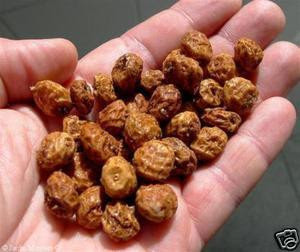Closely related names are used for the delicacy in various
languages: batarekh , butarkhah , batrakh (Arabic) or botarga (Occitan,
Spanish, and Catalan). The name bottarga is used in English and Italian. In
other languages it is called boutargue (French), butarga (Portuguese), and
butàriga (Sardinian), abudaraho (Turkish), avgotaraho (Greek αυγοτάραχο)
Added note received after publication from a Greek friend:
"Αυγο" means: Egg !! and Αυγοτάραχο means: Egg of the Fish !!.
Added note received after publication from a Greek friend:
"Αυγο" means: Egg !! and Αυγοτάραχο means: Egg of the Fish !!.
 |
| Bottarga بطارخ |
Bottarga Eaten as a Hors d'oeuvre, it is made from Fish roe.
Bottarga is the Italian name for a delicacy of salted, cured
fish roe, typically of the grey mullet frequently found near coastlines
throughout the world, that often is featured in Mediterranean cuisine and
consumed in many other regions of the world. The food bears many different
names and is prepared in several different ways.
The product is similar to the softer cured mullet roe,
karasumi from Japan and East Asia. Sometimes the delicacy is prepared from
tuna.
Etymology
The English name, bottarga, was borrowed from Italian. The
Italian form is thought to have been introduced from the Arabic buṭarḫah
بطارخة
(plural buṭariḫ
بطارخ),
but ultimately derives from Byzantine Greek ᾠοτάριχον (oiotárikhon)
The Italian form can be dated to ca. 1500, since the Greek
form transliterated into Latin as ova tarycha occurs in Bartolomeo Platina's De
Honesta Voluptate (ca. 1474), the earliest printed cookbook, and an Italian
manuscript dating shortly afterward that "closely parallels" this
cookbook attests to botarghe in the corresponding passage.
The first mention of the Greek form (oiotárikhon) occurs in
the writings of Simeon Seth in the eleventh century, who denounced the food as
something to be "avoided totally", although a similar phrase may have
been in use since antiquity in the same denotation. Although depicted in ancient Egypt, it has no known name.
Preparation
 Bottarga is made chiefly from the roe pouch of grey mullet.
Sometimes it is prepared from Atlantic bluefin tuna (bottarga di tonno) or
swordfish. It is massaged by hand to eliminate air pockets, then dried and
cured in sea salt for a few weeks. The result is a hard, dry slab that
sometimes is coated in beeswax for preservation purposes.
Bottarga is made chiefly from the roe pouch of grey mullet.
Sometimes it is prepared from Atlantic bluefin tuna (bottarga di tonno) or
swordfish. It is massaged by hand to eliminate air pockets, then dried and
cured in sea salt for a few weeks. The result is a hard, dry slab that
sometimes is coated in beeswax for preservation purposes.
Not all Bottarga is coated in beeswax as some producers
simply keep the natural casing of the roe intact, which contains the eggs
securely once dried and salted. The curing time may vary depending on producer
and the desired texture as well as the preference of the consumers, which
varies by country.
Sometimes called the caviar of the south, bottarga usually
is sliced thinly or grated when it is served. The delicacy currently is served
in many regions, including the following.
Croatia
In Croatia, the delicacy is known as butarga or butarda. It
usually is fried before serving.
France
In the French region, Provence, it is named Poutargue and
produced in the city of Martigues It also may be called boutargue in France.
Greece
In Greece, avgotaraho is produced primarily from the
flathead mullet caught in Greek lagoons. The whole mature ovaries are removed
from the fish, washed with water, salted with natural sea salt, dried under the
sun, and sealed in melted beeswax.
Italy
In Italy, it is best known in Sicilian and Sardinian cuisine
as bottarga; its culinary properties may be compared to those of dry anchovies,
although it is much more expensive. Often, it is served with olive oil or lemon
juice as an appetizer accompanied by bread or crostini. It also is used in
pasta dishes.
 Bottarga is categorized as a Traditional food product
(prodotto agroalimentare tradizionale). It varies by region, in particular, is
produced in Sardinia from flathead mullet and in Sicily from Atlantic bluefin
tuna.
Bottarga is categorized as a Traditional food product
(prodotto agroalimentare tradizionale). It varies by region, in particular, is
produced in Sardinia from flathead mullet and in Sicily from Atlantic bluefin
tuna.
Lebanon
In Lebanon it is served sliced, where each slice is covered
with a piece of raw garlic and the whole is immersed in olive oil, then eaten
with flat bread.
Turkey
In Turkey, bottarga is made from grey mullet roe. It is
listed in the Ark of Taste. It is produced in Dalyan, on the southwestern coast
of Turkey, from the mature fish migrating from Lake Köyceğiz.
Egypt
It is interesting to note that Bottarga is seen on
Ancient Egyptian murals from the old pharaohs world.




















